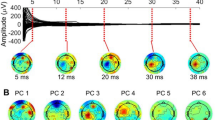Abstract
This paper addresses a method of blind source separation that jointly exploits the nonstationarity and temporal structure of sources. The method needs only multiple time-delayed correlation matrices of the observation data, each of which is evaluated at different time-windowed data frame, to estimate the demixing matrix. The method is insensitive to the temporally white noise since it is based on only time-delayed correlation matrices (with non-zero time-lags) and is applicable to the case of either nonstationary sources or temporally correlated sources. We also discuss the extension of some existing methods with the overview of second-order blind source separation methods. Extensive numerical experiments confirm the validity and high performance of the proposed method.
Similar content being viewed by others
References
L. Tong, Y. Inouye, and R. Liu, “Waveform-Preserving Blind Estimation of Multiple Independent Sources,” IEEE Trans. Signal Processing, vol. 41, 1993, pp. 2461-2470.
S. Haykin, Unsupervised Adaptive Filtering: Blind Source Separation, Prentice-Hall, 2000.
S. Amari and A. Cichocki, “Adaptive Blind Signal Processing—Neural Network Approaches,” in Proc. of the IEEE, Special Issue on Blind Identification and Estimation, vol. 86,no. 10, 1998, pp. 2026-2048.
J.F. Cardoso, “Blind Signal Separation: Statistical Principles,” in Proc. of the IEEE, Special Issue on Blind Identification and Estimation, vol. 86,no. 10, 1998, pp. 2009-2025.
L. Tong, V.C. Soon, Y.F. Huang, and R. Liu, “AMUSE: A New Blind Identification Alogrithm,” in Proc. ISCAS, 1990, pp. 1784-1787.
L. Molgedey and H.G. Schuster, “Separation of a Mixture of Independent Signals Using Time Delayed Correlations,” Physical Review Letters, 1994, pp. 3634-3637.
A. Belouchrani, K. Abed-Merain, J.F. Cardoso, and E. Moulines, “A Blind Source Separation Technique Using Second Order Statistics,” IEEE Trans. Signal Processing, vol. 45, 1997, pp. 434-444.
K. Matsuoka, M. Ohya, and M. Kawamoto, “A Neural Net for Blind Separation of Nonstationary Signals,” Neural Networks, vol. 8,no. 3, 1995, pp. 411-419.
S. Choi, A. Cichocki, and S. Amari, “Equivariant Nonstationary Source Separation,” Neural Networks, to appear.
S. Choi and A. Cichocki, “Blind Separation of Nonstationary Sources in Noisy Mixtures,” Electronics Letters, vol. 36, 2000, pp. 848-849.
D.T. Pham and J.F. Cardoso, “Blind Separation of Instantaneous Mixtures of Nonstationary Sources,” in Proc. ICA, Helsinki, Finland, 2000, pp. 187-192.
S. Choi and A. Cichocki, “Blind Separation of Nonstationary and Temporally Correlated Sources from Noisy Mixtures,” in Proc. IEEE Workshop on Neural Networks for Signal Processing, Sidney, Austrailia, 2000, pp. 405-414.
A. Belouchrani and M.G. Amin, “Blind Source Separation Based on Time-Frequency Signal Representations,” IEEE Trans. Signal Processing, vol. 46, 1998, pp. 2888-2897.
C. Chang, Z. Ding, S.F. Yau, and F.H.Y. Chan, “A Matrix-Pencil Approach to Blind Separation of Colored Nonstationary Signals,” IEEE Trans. Signal Processing, vol. 48, 2000, pp. 900-907.
J.F. Cardoso, “Source Separation Using Higher-Order Moments,” in Proc. ICASSP, 1989.
K. Fukunaga, An Introduction to Statistical Pattern Recognition, New York, NY: Academic Press, 1990.
G.H. Golub and C.F.V. Loan, Matrix Computations, 2nd edn., Johns Hopkins, 1993.
L. Tong, Y. Inouye, and R. Liu, “A Finite-Step Global Convergence Algorithm for the Parameter Estimation of Multichannel MA Processes,” IEEE Trans. Signal Processing, vol. 40, 1992, pp. 2547-2558.
K.R. Müller, P. Philips, and A. Ziehe, “JADETD: Combining Higher-Order Statistics and Temporal Information for Blind Source Separation (with Noise),” in Proc. ICA'99, Aussois, France, 1999, pp. 87-92.
A. Belouchrani, “Séparation Autodidacte de Sources: Algorithme, Performances et Application a des Signaux Expérimentaux,” Ph.D. Thesis, ENST, Telecom Paris, July 1995.
A. Belouchrani and A. Cichocki, “Robust Whitening Procedure in Blind Source Separation Context,” Electronics Letters, vol. 36, 2000, pp. 2050-2051.
A. Souloumiac, “Blind Source Detection and Separation Using Second Order Non-Stationarity,” in Proc. ICASSP, 1995, pp. 1912-1915.
J.F. Cardoso and A. Souloumiac, “Jacobi Angles for Simultaneous Diagonalization,” SIAM J. Mat. Anal. Appl., vol. 17, 1996, pp. 161-164.
D.T. Pham, “Joint Approximate Diagonalization of Positive Definite Hermitian Matrices,” Tech. Rep. LMC/IMAG, University of Grenoble, France, 2000.
J.F. Cardoso and A. Souloumiac, “Blind Beamforming for Non Gaussian Signals,” IEE Proceedings-F, vol. 140,no. 6, 1993, pp. 362-370.
Author information
Authors and Affiliations
Rights and permissions
About this article
Cite this article
Choi, S., Cichocki, A. & Beloucharni, A. Second Order Nonstationary Source Separation. The Journal of VLSI Signal Processing-Systems for Signal, Image, and Video Technology 32, 93–104 (2002). https://doi.org/10.1023/A:1016319502849
Published:
Issue Date:
DOI: https://doi.org/10.1023/A:1016319502849




